Latin America Immersive Entertainment Market Size
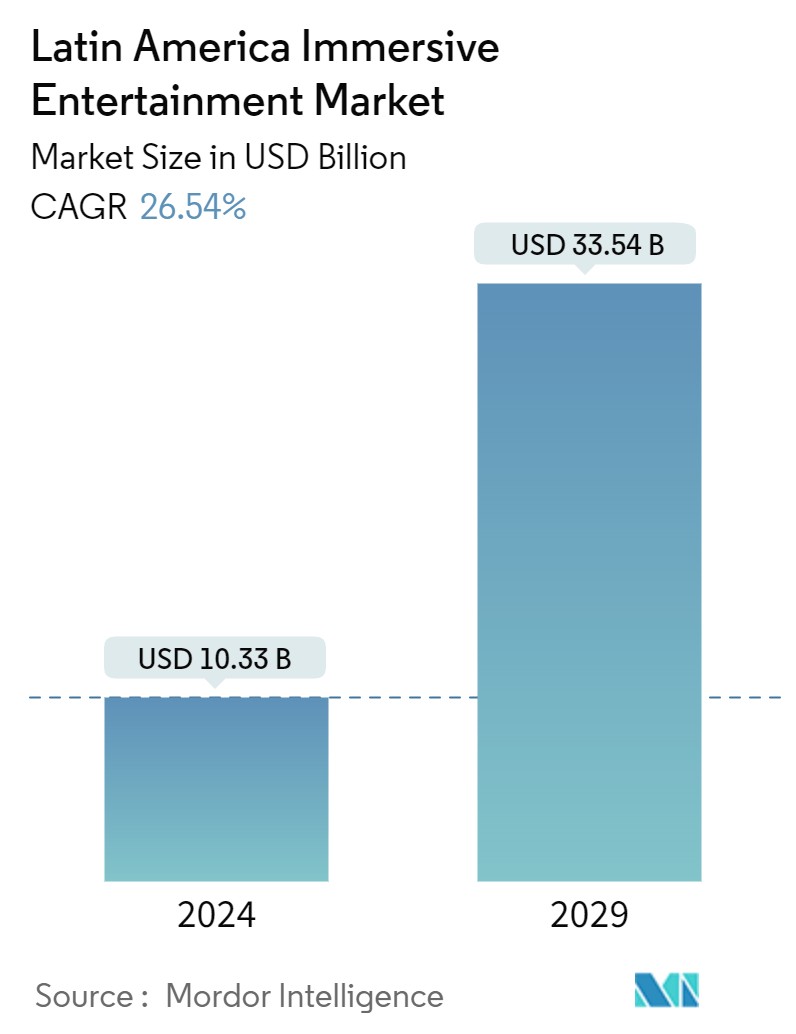
| Study Period | 2019 - 2029 |
| Base Year For Estimation | 2023 |
| Market Size (2024) | USD 10.33 Billion |
| Market Size (2029) | USD 33.54 Billion |
| CAGR (2024 - 2029) | 26.54 % |
| Market Concentration | Medium |
Major Players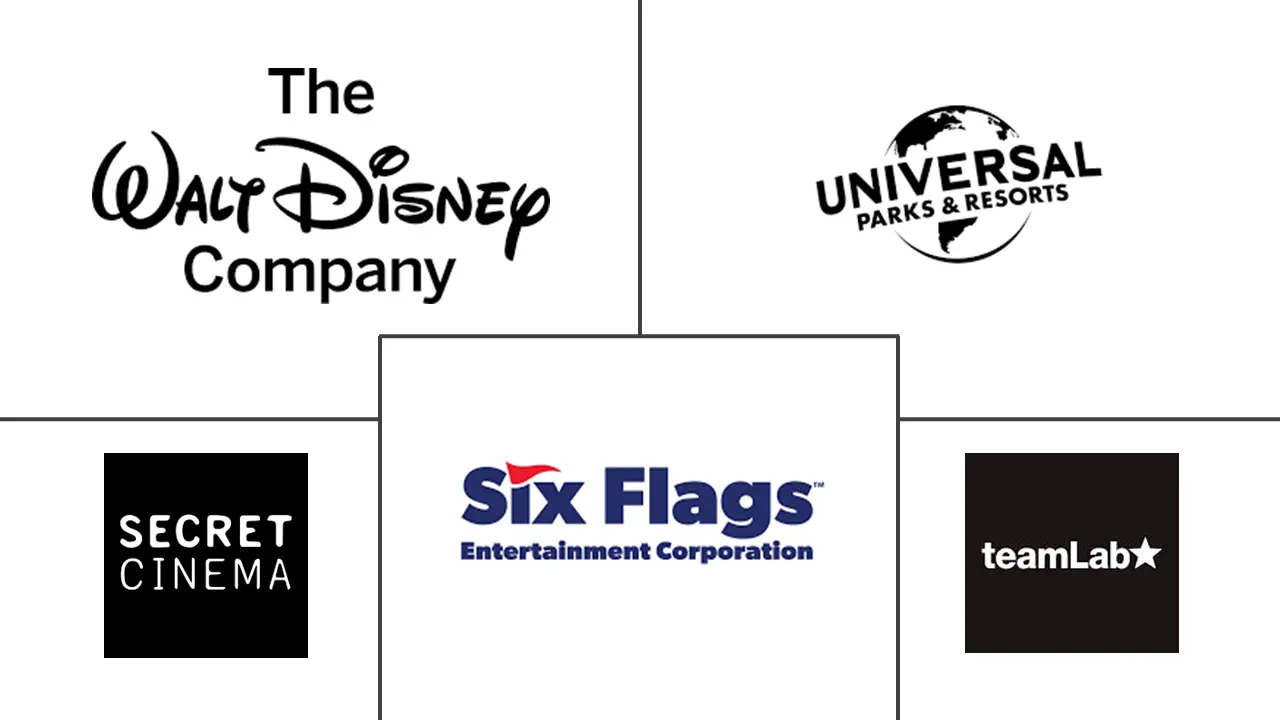
*Disclaimer: Major Players sorted in no particular order |
Latin America Immersive Entertainment Market Analysis
The Latin America Immersive Entertainment Market size is estimated at USD 10.33 billion in 2024, and is expected to reach USD 33.54 billion by 2029, growing at a CAGR of 26.54% during the forecast period (2024-2029).
- Immersive technologies are increasingly adopted in the entertainment industry, a trend poised to drive the market's growth in the coming years. Additionally, virtual tourism is gaining traction, allowing users to explore various destinations virtually. These evolving trends underscore the dynamic nature of immersive technologies in entertainment and highlight a shift in the market. The rise of virtual tourism signals an increasing demand for diverse and engaging immersive experiences, fundamentally changing audience interactions with entertainment.
- Further, the market is poised for growth, driven by the surge in location-based entertainment (LBE). LBE utilizes immersive technologies to create unique experiences in physical venues like theme parks and entertainment centers. By offering consumers innovative and interactive experiences that transcend traditional home entertainment, LBE significantly broadens the market. This trend is set to propel the growth of the immersive entertainment market during the forecast period. Additionally, the rise of virtual concerts and events allows consumers to enjoy live entertainment from the comfort of their homes, catering to evolving preferences for accessible experiences.
- For example, Sandbox VR is producing a full-body LBVR experience based on Netflix’s “Squid Game,” where contestants venture to iconic locations from the show to compete against one another. Motion Reality, Springboard VR, and Zero Latency all host similar free-roaming experiences for visitors equipped with tetherless VR and motion-capture gear to engage in highly immersive multiplayer battles set in massive virtual arenas. Family-friendly providers of standalone VR experiences include Dreamscape and DivrLabs, inviting guests to embark on virtual adventures set in fantasy realms, from prehistoric jungles to apocalyptic zombies.
- Further, VR arcades are innovating and offering more immersive experiences. VR arcades are expected to maintain healthy sales and a more significant market position in the immersive VR ecosystem. This is evident by the fact that among all the applications, VR arcades are expected to occupy the maximum share and have the fastest growth rate. In the next few years, high-end out-of-home immersive experiences, like Nomadic, Dreamscape, and The Void, are anticipated to develop and offer more affordable immersive experiences for the home. In the current market scenario, more content creators are building experiences specifically for VR Arcades. For instance, companies like Indie Studios realize they can generate positive profit margins by developing content specifically for the out-of-home VR space.
- Immersive technologies grapple with technical constraints tied to hardware, software, and content creation. For instance, VR headsets might offer a restricted field of view or resolution, diminishing the immersive experience. Similarly, AR applications can face challenges in accurately superimposing digital content onto the real world, influenced by environmental factors and the precision of device tracking. Furthermore, producing top-notch immersive content demands expertise in 3D modeling, animation, and interactive design, an intricate and time-intensive process.
Latin America Immersive Entertainment Market Trends
The Themed Entertainment Segment is Expected to Hold a Significant Share in the Market
- Virtual reality (VR) technology is reshaping the theme park industry. Theme parks are not only enhancing their current attractions with VR but are also introducing stand-alone VR rides. While traditional theme parks pour millions into VR tech to boost attendance, some organizations are going a step further by investing billions to create dedicated VR theme parks. Beyond just VR theme parks and amusement parks, technology is making waves elsewhere. Travel agencies, shopping malls, and clothing retailers are leveraging VR to offer visitors and tourists captivating experiences.
- Moreover, Hello Park LLC, an immersive park chain, partnered with the StarParks division of Brazil's GSJ Group, which owns the country's largest indoor amusement park, Parque de Monica. Together, they inaugurated the world's largest digital theme park for children in Sao Paulo. This park marks the 21st addition to the Hello Park chain, spanning 1,500 sq.m, with 1,300 meters dedicated to interactive experiences. The park boasts over 20 immersive zones. Additional features include a family cafe, interactive rooms for family celebrations, and a merchandise store.
- Theme entertainment parks increasingly prioritize sustainability, integrating eco-friendly practices into their designs and operations. Additionally, attractions centered around beloved franchises from film, television, and games are reshaping the thematic entertainment landscape. These elements elevate the guest experience, boost visitor engagement, encourage repeat visits, and foster brand loyalty. The theme park market is poised for a transformative future, with top brands continually pushing creative and innovative boundaries.
- In July 2024, DOF Robotics, known for its dynamic simulation platforms, unveiled its latest attraction, The Flying Theater, in Guadalajara, Mexico. This cutting-edge attraction elevates the thrill and immersion levels, transforming the entertainment experience for all visitors. Accommodating up to 40 guests, this flying theater ensures an exhilarating experience, even for those sensitive to motion and spatial changes. As guests' seats are smoothly elevated toward a vast domed screen, they are made to feel as if they're gliding over captivating landscapes and thrilling scenarios.
- The rise in the number of tourists in the region would create an opportunity for the market players to establish immersive entertainment locations in the region. For instance, according to the World Tourism Organization, in 2023, Mexico emerged as the leading destination for international tourists in Latin America, attracting over 42 million arrivals. The Dominican Republic secured the second spot, albeit at a considerable distance.
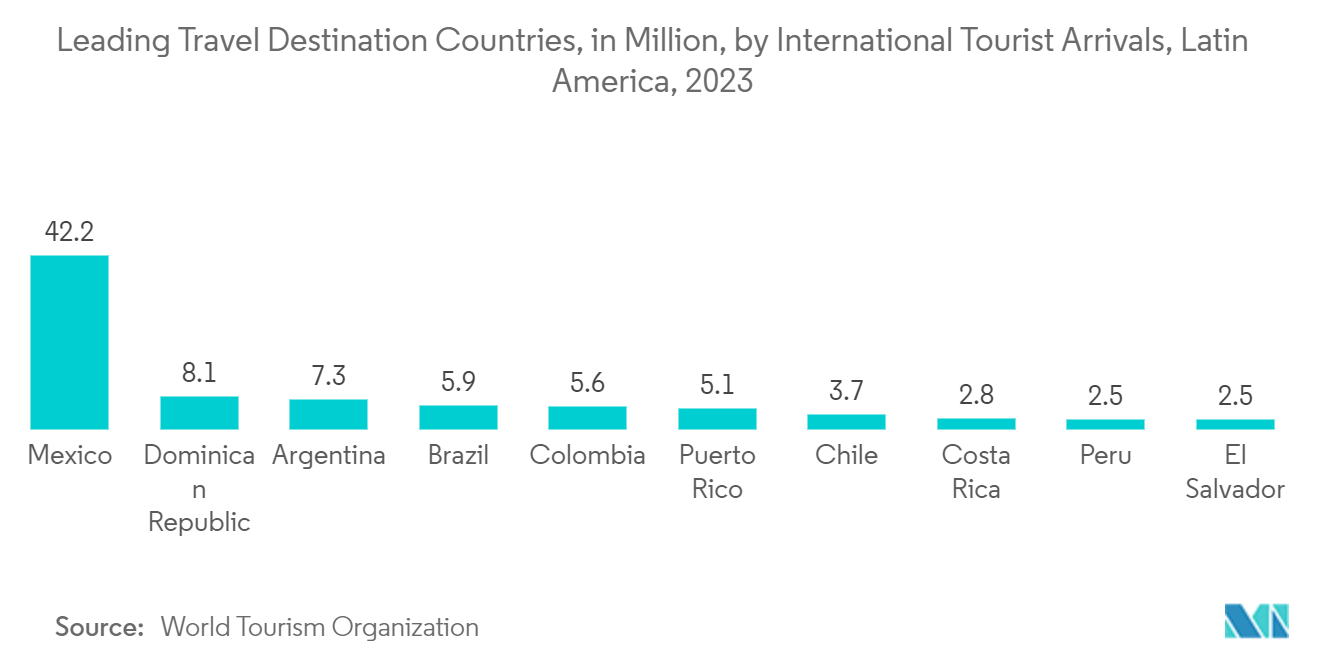
Brazil is Expected to Hold a Significant Share
- Brazil is poised for rapid growth, driven by its rich cultural heritage and history. This backdrop creates an ideal setting for innovative immersive technologies in venues like museums, theaters, and heritage sites. Such technologies elevate visitor experiences, providing unique and interactive engagements with cultural and historical artifacts. Furthermore, Europe's proactive investment in technological infrastructure and the rising acceptance of these advanced experiences among its consumers further bolster the region's potential for significant market growth.
- The primary drivers of the Brazilian market are the rising population spending on outdoor activities and the use of 3D technology at entertainment locations offering a realistic experience. Moreover, the growth can be credited to a rise in the consumer inclination toward arcade studios, amusement parks, and 4D films as a part of leisure. Also, a rise in disposable incomes, rapid urbanization, and an increase in international tourism are driving the growth of the immersive entertainment market.
- Across various cities, immersive entertainment is drawing packed crowds. From Meow Wolf's interactive psychedelic fun houses to Dreamscape's full-roam multiplayer VR adventures and the immersive Van Gogh exhibits, a burgeoning 'experience economy' is taking shape. This economy melds traditional artistry with innovative immersive experiences, hinting at potential transformations for malls, museums, and theme parks. Their vision extends beyond individual events, as they are establishing networks of venues primed for future immersive showcases.
- Furthermore, with the proliferation of technologies such as AI, ML, and IoT also growing in the AR/VR industry, the use cases and capabilities of the technologies are anticipated to expand further, creating a growth outlook during the forecast period. For instance, incorporating AI components, such as ontology and deep learning, into AR/VR can improve these several strategies. For example, the artificial intelligence algorithm can be applied to augmented/virtual reality to offer users improved interactions with their physical environment. AI algorithms can also collect more detailed data from multiple complementary AR/VR sensors, such as GPS and gyroscopes. Additionally, AI can be used with immersive technologies to offer better mobile experiences by enhancing smartphone speech recognition, object detection, and image tracking.
- According to Registro de Museos Iberoamericanos, as of November 2023, Brazil boasted approximately 3,800 museums, leading all major Latin American countries. Mexico had over 1,200 museums, while Argentina followed with 1,017 cultural centers. Such a huge number of museums in the country is expected to propel the studied market.
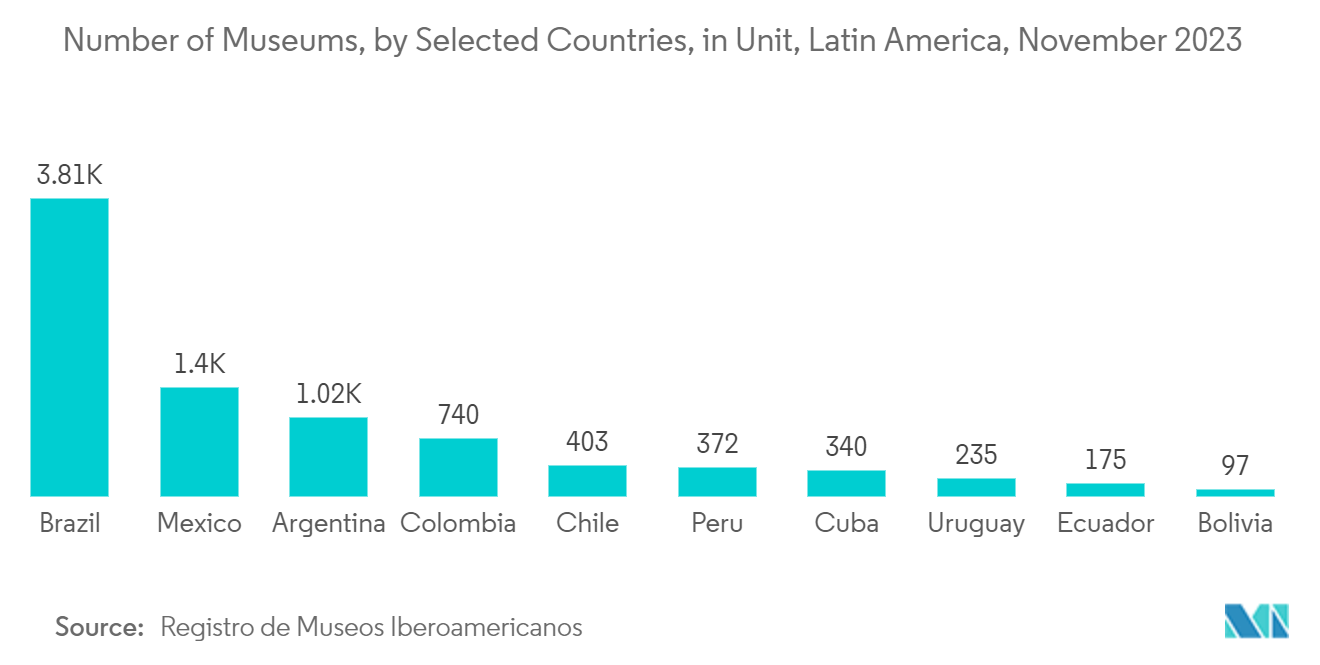
Latin America Immersive Entertainment Industry Overview
The Latin American immersive entertainment market is semi-consolidated due to the presence of few players. Some of the major players in the market are TeamLab, Secret Cinema, The Walt Disney Company, Universal Parks & Resorts, and Six Flags Entertainment Corporation. The players are adopting strategies such as partnerships and acquisitions to enhance their product offerings and gain a competitive advantage.
- June 2024: Wevr, a studio specializing in interactive and spatial experiences, secured an additional USD 3.5 million in funding from HTC Corp. and Epic Games. HTC and Epic, original investors in Wevr, are bolstering their stakes as the studio enhances its Virtual Studio technology and real-time 3D production capabilities. With advancements in spatial computing and emerging headset technologies, brands now face unparalleled opportunities to engage communities in innovative ways.
- January 2024: Apple unveiled a suite of innovative entertainment experiences set to debut on the Apple Vision Pro. Each eye benefits from more pixels than a standard 4K TV. When paired with an advanced Spatial Audio system, Vision Pro allows users to stream top-tier shows and films, including Apple Originals from Apple TV+. Users can also immerse themselves in breathtaking landscapes through Environments and engage in unprecedented spatial experiences, such as Encounter Dinosaurs. Apple Vision Pro has ultra-high-resolution micro-OLED displays, delivering a combined 23 million pixels, ensuring an immersive viewing experience with vibrant colors, exceptional clarity, wide color gamut, high dynamic range, and Dolby Vision.
Latin America Immersive Entertainment Market Leaders
-
teamLab
-
The Walt Disney Company
-
Universal Parks & Resorts
-
Six Flags Entertainment Corporation
-
Secret Cinema
*Disclaimer: Major Players sorted in no particular order
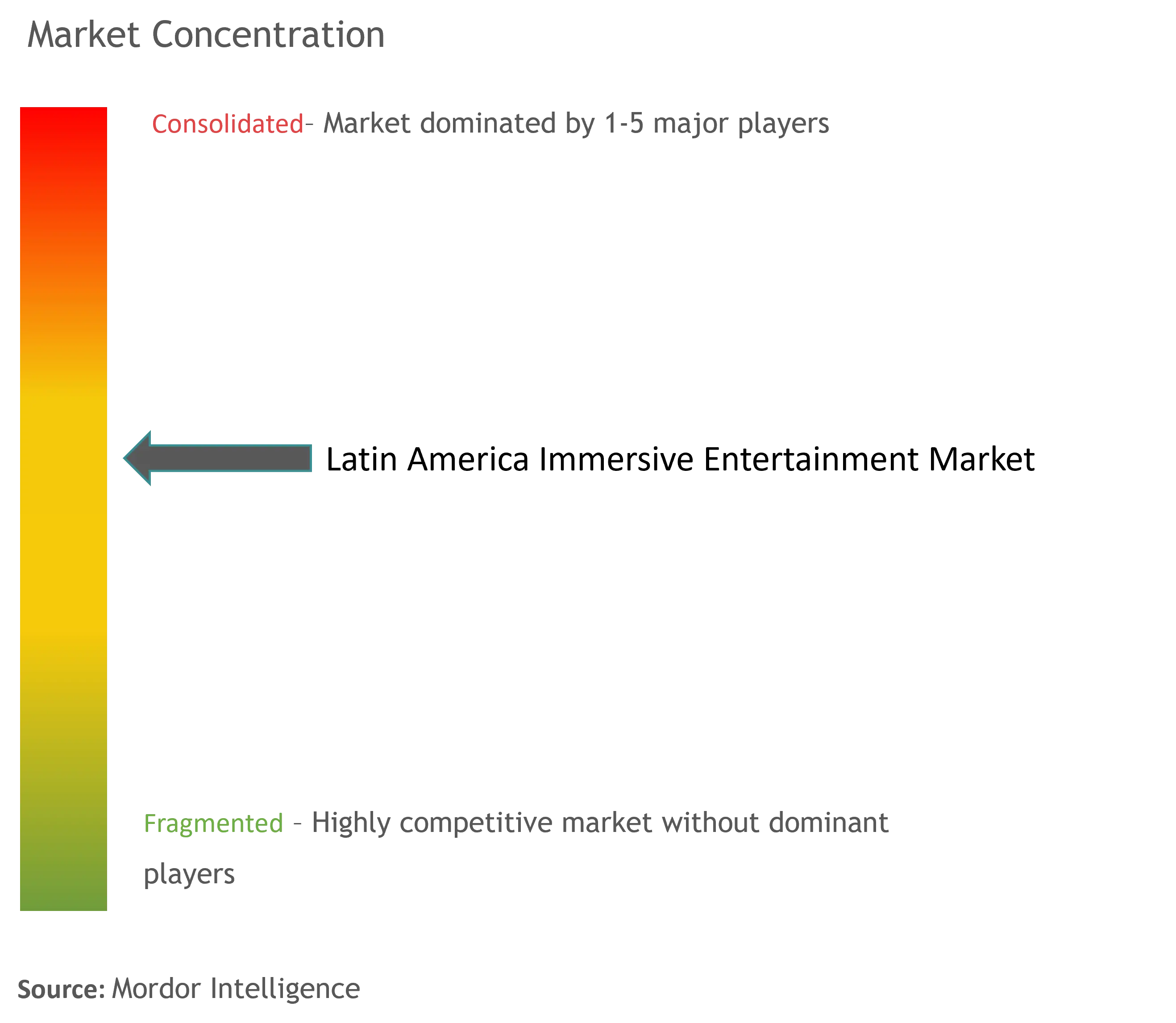
Latin America Immersive Entertainment Market News
- August 2024: Super League, a key player in reshaping the gaming industry as a media channel, teamed up with Meta-Stadiums, an innovative platform for crafting and overseeing virtual stadiums in the metaverse. This strategic collaboration aims to merge their strengths, delivering cross-platform immersive experiences and events tailored for music artists, sports teams, entertainment firms, and consumer brands. This partnership positions them as a premier end-to-end metaverse programs and strategies provider, extending their reach throughout the virtual universe. Their offerings span from custom 3D environments to immersive platforms, including Roblox, Fortnite Creative, The Sandbox, Decentraland, and Minecraft.
- January 2024: Sony Corporation unveiled an advanced spatial content creation system. This system features an XR head-mounted display boasting high-quality 4K OLED Microdisplays and a video see-through function. Additionally, it comes with a pair of controllers designed for intuitive interaction with 3D objects and precise pointing. This system facilitates sophisticated 3D content development. Sony is set to collaborate with a diverse range of 3D production software developers, spanning both entertainment and industrial design sectors. At its launch, Sony forged an exclusive partnership with Siemens, a frontrunner in industrial technology. Together, they are set to roll out a cutting-edge solution for immersive design and collaborative product engineering, leveraging software from Siemens' Xcelerator open digital business platforms.
Latin America Immersive Entertainment Market Report - Table of Contents
1. INTRODUCTION
- 1.1 Study Assumptions and Market Definition
- 1.2 Scope of the Study
2. RESEARCH METHODOLOGY
3. EXECUTIVE SUMMARY
4. MARKET INSIGHTS
- 4.1 Market Overview
- 4.2 Industry Ecosystem Analysis
-
4.3 Use Cases of Enabling Technologies
- 4.3.1 Flat User Interface for 2D Experience
- 4.3.2 Extended Reality (3D)
- 4.3.3 Natural and Spatial Interfaces
5. MARKET DYNAMICS
-
5.1 Market Drivers
- 5.1.1 Creative Success in the Entertainment Industry is Driving the Revenue's Growth in the Sector
-
5.2 Market Challenges
- 5.2.1 Sustainability and Growth Expansion in the Immersive Entertainment Sector Remains Challenging
6. MARKET SEGMENTATION
-
6.1 Application
- 6.1.1 Themed Entertainment
- 6.1.2 Haunted Attractions and Escape Rooms
- 6.1.3 Immersive Theatre
- 6.1.4 Experiential Art Museums
- 6.1.5 Other Applications (Exhibitions, etc.)
-
6.2 Country
- 6.2.1 Brazil
- 6.2.2 Mexico
- 6.2.3 Argentina
- 6.2.4 Rest of Latin America
7. COMPETETIVE LANDSCAPE
-
7.1 Company Profiles*
- 7.1.1 TeamLab
- 7.1.2 Secret Cinema
- 7.1.3 The Walt Disney Company
- 7.1.4 Universal Parks & Resorts
- 7.1.5 Six Flags Entertainment Corporation
- 7.1.6 Cedar Fair Entertainment Company
8. INVESTMENT ANALYSIS
9. MARKET OPPORTUNITIES AND FUTURE TRENDS
** Subject To AvailablityLatin America Immersive Entertainment Industry Segmentation
The immersive entertainment market is leading a significant shift in how people interact with digital content. Dominated by technologies like virtual reality (VR), augmented reality (AR), and mixed reality (MR), this market has seen remarkable growth fueled by technological innovations and an increasing appetite for engaging and interactive experiences.
The Latin American immersive entertainment market is segmented by application (themed entertainment, haunted attractions and escape rooms, immersive theatre, experiential art museums, and other applications) and country (Brazil, Mexico, Argentina, and Rest of Latin America). The report offers the market size and forecasts in value (USD) for all the above segments.
| Application | Themed Entertainment |
| Haunted Attractions and Escape Rooms | |
| Immersive Theatre | |
| Experiential Art Museums | |
| Other Applications (Exhibitions, etc.) | |
| Country | Brazil |
| Mexico | |
| Argentina | |
| Rest of Latin America |
Latin America Immersive Entertainment Market Research FAQs
How big is the Latin America Immersive Entertainment Market?
The Latin America Immersive Entertainment Market size is expected to reach USD 10.33 billion in 2024 and grow at a CAGR of 26.54% to reach USD 33.54 billion by 2029.
What is the current Latin America Immersive Entertainment Market size?
In 2024, the Latin America Immersive Entertainment Market size is expected to reach USD 10.33 billion.
Who are the key players in Latin America Immersive Entertainment Market?
teamLab, The Walt Disney Company, Universal Parks & Resorts, Six Flags Entertainment Corporation and Secret Cinema are the major companies operating in the Latin America Immersive Entertainment Market.
What years does this Latin America Immersive Entertainment Market cover, and what was the market size in 2023?
In 2023, the Latin America Immersive Entertainment Market size was estimated at USD 7.59 billion. The report covers the Latin America Immersive Entertainment Market historical market size for years: 2019, 2020, 2021, 2022 and 2023. The report also forecasts the Latin America Immersive Entertainment Market size for years: 2024, 2025, 2026, 2027, 2028 and 2029.
Latin America Immersive Entertainment Industry Report
Statistics for the 2024 Latin America Immersive Entertainment market share, size and revenue growth rate, created by Mordor Intelligence™ Industry Reports. Latin America Immersive Entertainment analysis includes a market forecast outlook for 2024 to 2029 and historical overview. Get a sample of this industry analysis as a free report PDF download.



